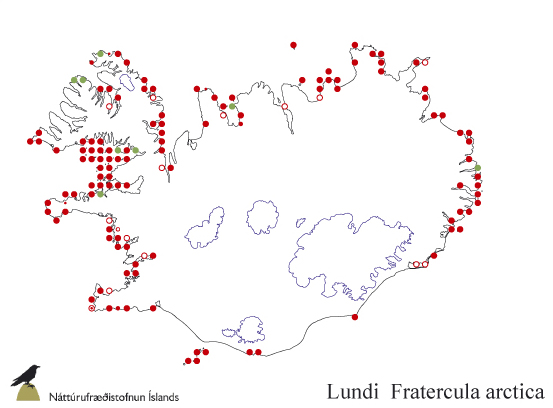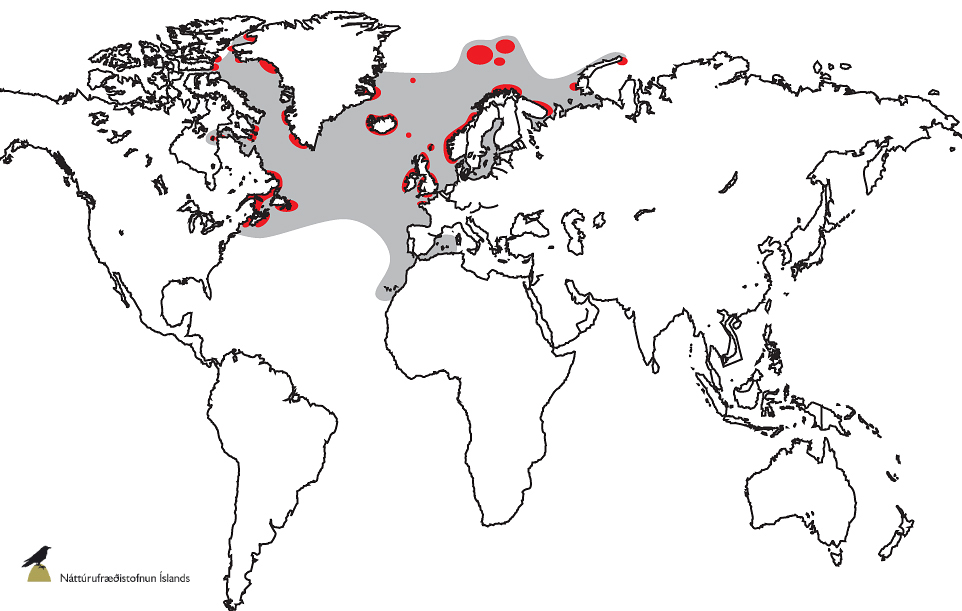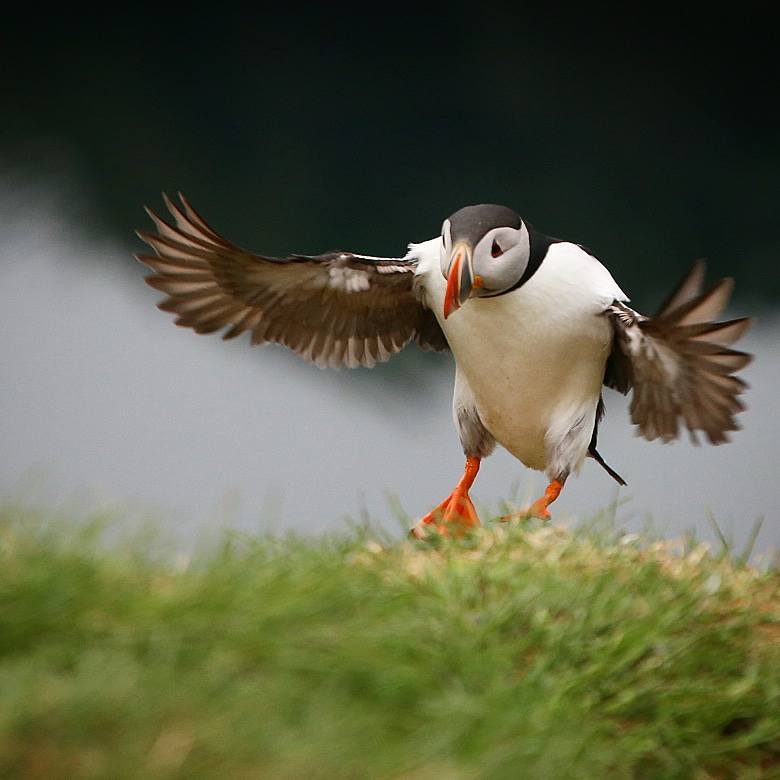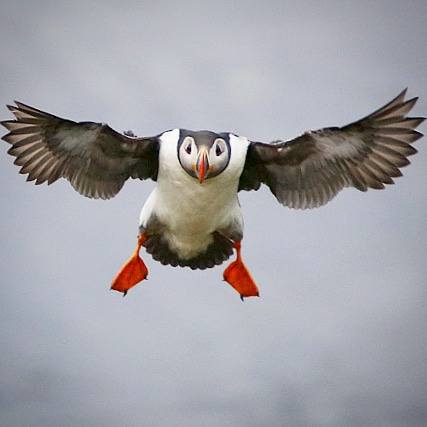More about birdlife
The Puffin
 The Atlantic Puffin, usually simply called the Puffin, is a member of the auk family and is the most common auk in Iceland. The upright stance and black and white plumage of auks remind some people of penguins although the two families are in fact not closely related. Two other species of puffin, the Horned Puffin (Fratercula corniculata) and the Tufted Puffin (Fratercula cirrhata) occur in the North Pacific Ocean.
The Atlantic Puffin, usually simply called the Puffin, is a member of the auk family and is the most common auk in Iceland. The upright stance and black and white plumage of auks remind some people of penguins although the two families are in fact not closely related. Two other species of puffin, the Horned Puffin (Fratercula corniculata) and the Tufted Puffin (Fratercula cirrhata) occur in the North Pacific Ocean.
The Puffin's scientific name is Fratercula arctica. The name of the genus, Fratercula, literally means "little priest" or "little brother," while arctica is a reference to the species' northerly distribution. The reference to a priest echoes the bird's Icelandic nickname, prófastur (=dean). Both presumably refer to the bird's black-and-white "vestments" and upright posture. It is called lundi in Icelandic, lunde in Danish and Norwegian, lunnefågel in Swedish, Papageitaucher in German and macareux moine in French. The Puffin is probably the most common bird in Borgarfjörður eystri. An estimated 8,000-10,000 pairs breed at Hafnarhólmi and non-breeding birds also visit the colony later in the summer.
Population
 Approximately 5.7-7.3 million pairs of Puffins breed in Europe. It is the most numerous bird in Iceland, with a population estimated at 8-13 million individuals and a breeding population of 3-4 million pairs. The population is believed to have declined in recent years as a consequence of poor breeding success and high mortality rates of young birds, a consequence of a shortage in fish prey. The 8,000-10,000 pairs which breed at Hafnarhólmi represent a mere fraction of the Icelandic population, or 0.25%. Approximately 60% of the world’s Atlantic Puffins breed in Iceland
Approximately 5.7-7.3 million pairs of Puffins breed in Europe. It is the most numerous bird in Iceland, with a population estimated at 8-13 million individuals and a breeding population of 3-4 million pairs. The population is believed to have declined in recent years as a consequence of poor breeding success and high mortality rates of young birds, a consequence of a shortage in fish prey. The 8,000-10,000 pairs which breed at Hafnarhólmi represent a mere fraction of the Icelandic population, or 0.25%. Approximately 60% of the world’s Atlantic Puffins breed in Iceland
Global Distribution
 The Puffin breeds on both sides of the North Atlantic, from Maine in the United States and Brittany in France north to Svalbard. It spends the winters far out at sea. Immature Icelandic Puffins overwinter in the seas off Newfoundland and adult birds are found off southern Greenland. Puffins are generally found in Iceland from the beginning of April until September and are rare close to land in winter.
The Puffin breeds on both sides of the North Atlantic, from Maine in the United States and Brittany in France north to Svalbard. It spends the winters far out at sea. Immature Icelandic Puffins overwinter in the seas off Newfoundland and adult birds are found off southern Greenland. Puffins are generally found in Iceland from the beginning of April until September and are rare close to land in winter.
Summer and Winter
Young puffins from Iceland spend the winter off the coasts of Newfoundland. The older birds stay south of Greenland, but keep away from the shore. Puffins stay in Iceland from the beginning of april until september.
Habits
 The Puffin is a long-lived bird and the average life expectancy is estimated to be around 20-25 years. The oldest Puffin on record is one that Óskar J. Sigurðsson ringed in the Westman Islands which was 38 years old when recovered. Puffins are highly social birds. They are believed to be a faithful to their mates and generally pair for life. The parents share the chick-rearing duties. Eggs are laid from late May into early June. A single egg is laid in burrow which can be up to half a metre in length. The egg weighs around 60 grams, similar to a hen’s egg. The young leave the nesting burrow around 45 days after hatching and head out to sea. They reach sexual maturity at around the age of 4-5 years. Puffins are excellent swimmers and can dive to depths of up to sixty metres. They are also strong flyers and their 400 wing beats a minute can propel them to up to speeds of 90 km/h. They feed mainly on fish (sand-eel, capelin and fry of various species), squid and crustaceans and can carry up to ten fish at a time in their bills. The Puffin's main enemy is the Great Black-backed Gull which is capable of swallowing a Puffin in a single gulp. Kittiwakes often steal food from Puffins, and Herring Gulls, Arctic Skuas, Great Skuas and Gyr Falcons also prey on Puffins.
The Puffin is a long-lived bird and the average life expectancy is estimated to be around 20-25 years. The oldest Puffin on record is one that Óskar J. Sigurðsson ringed in the Westman Islands which was 38 years old when recovered. Puffins are highly social birds. They are believed to be a faithful to their mates and generally pair for life. The parents share the chick-rearing duties. Eggs are laid from late May into early June. A single egg is laid in burrow which can be up to half a metre in length. The egg weighs around 60 grams, similar to a hen’s egg. The young leave the nesting burrow around 45 days after hatching and head out to sea. They reach sexual maturity at around the age of 4-5 years. Puffins are excellent swimmers and can dive to depths of up to sixty metres. They are also strong flyers and their 400 wing beats a minute can propel them to up to speeds of 90 km/h. They feed mainly on fish (sand-eel, capelin and fry of various species), squid and crustaceans and can carry up to ten fish at a time in their bills. The Puffin's main enemy is the Great Black-backed Gull which is capable of swallowing a Puffin in a single gulp. Kittiwakes often steal food from Puffins, and Herring Gulls, Arctic Skuas, Great Skuas and Gyr Falcons also prey on Puffins.
Puffins in Iceland, eastern Iceland and in Borgarfjörður eystri
Although the largest Puffin colonies in eastern Iceland are well known, the overall distribution on eastern Iceland has not been as extensively studied. The best known, and largest, colonies are at Skrúður, Papey, Seley, Andey, Hafnarhólmi, Hólmar in Reyðarfjörður (Stórhólmi), Bjarnarey, Gerpi and at Hestur on the southern side of Barðsnes. The colony at Andey holds several dozen pairs. Around twenty-five years ago (1986) the colony at Papey numbered 200,000 pairs. The name Papey, or Friars’ Island, is thought to come from the Puffins rather than the Irish friars who are reputed to have settled here centuries ago but left nothing behind. There are historical records of Puffin colonies widely in the area around Djúpivogur and Berufjörður. Great rafts of Puffins may be seen on the sea between the mainland and Skrúður and also in the bay Héraðsflói in summer where they forage. Puffins may also be seen in flight or resting on the sea along many parts of the coast. Puffins are rarely encountered in eastern Iceland in winter and auk hunters never catch Puffins in the region’s fjords at that time of year.
 Hunting Puffins in Iceland
Hunting Puffins in Iceland
The Puffin is one of the most popular game birds in Iceland. According to the figures issued by the Environment Agency of Iceland, 64,008-232,936 Puffins were hunted annually between 1995 and 2007. Hunting has decreased in recent years and restrictions have been imposed in the Westman Islands. Approximately half of all Puffins are caught in the Westman Islands but the use of traditional pole-nets has dropped sharply. The mortality rate of young Puffins has also been high there in recent years.
Ringing Puffins
The Southern Iceland Natural History Institute has in recent years colour-ringed and electronically tagged Puffins in the Westman Islands and has carried out extensive research on the bird in order to gain a deeper insight into the travels and habits of this endearing bird. Indeed the vast majority of Puffins ringed in Iceland have been in the Westman Islands. Óskar J. Sigurðsson, the lighthouse keeper at Stórhöfði, has ringed more than 54,000 Puffins. Puffins are caught in pole-nets and then released once ringed.
